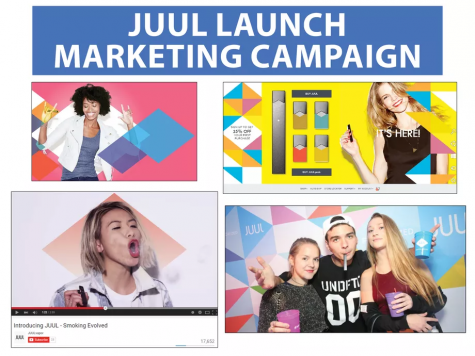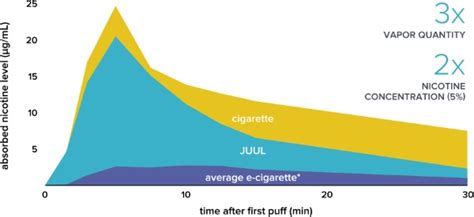“JUULing” and Stamford High School
An in-depth look into the FDA’s investigation on JUUL and its effect on youth.
Shayna Druckman and Isabella Sorial
November 21, 2018
Editor’s Note: Students were generally unwilling to be named as e-cig users in the course of our interviewing; therefore, we have chosen to allow the use of anonymous sources in this article. Additonally, this story details our attempts to purchase JUUL products online; we wish to be clear that our attempts were solely investigative in nature and did not result in the actual purchase of a product.
On November 13, Juul Labs announced that it would stop accepting retail orders for mango, fruit, creme, and cucumber flavored Juul pods in compliance with a US Food and Drug Administration (FDA) investigation.
A “Juul” is an electronic cigarette that was created as a tool for adults trying to quit smoking cigarettes. But not only are they used by adults trying to fight nicotine addiction; teenagers are using them to get their first taste of it. The product greatly appeals to students as they can customize their Juuls with decorative skins and various sweet flavors, easily charge them with their small USB adapters, and disguise them as harmless flash drives.
As a for-profit company that is not inhibited by the same regulations as regular tobacco companies, the product was allowed to soar through the market. According to journalist Kimberly Suiters of ABC7, sales of Juul increased by 700 percent in 2016. The FDA even attempted to ease regulations on the e-cigarette industry in 2017 as a way to encourage the development of products to help adults quit smoking. Critics (like the Truth Initiative) argued that the FDA did not do enough to prevent youths from using products like Juul. Data from the Centers for Disease Control and Prevention’s National Youth Tobacco Survey show that 3.6 million middle and high school students currently use e-cigarettes, 1.5 million more than last year. As reported by Mahita Gajanan of Time, 10.8 million Americans use e-cigarettes, and more than half of those users are under 35 years old.

Now the FDA has accused Juul of marketing to youths intentionally, and if they can prove it, Juuls (and possibly other e-cigarettes) may be taken off of the market forever.
One apparent benefit of inhaling e-cigarette fluid as opposed to inhaling from a regular cigarette is that it has fewer toxic compounds. However, according to Jonathan Philip Winickoff, M.D., a smoking cessation specialist, Juuls are made with a chemical called N-Nitrosonornicotine (the most carcinogenic substance we know of) and Acrylonitrile, a highly poisonous compound used in plastics, adhesives, and synthetic rubbers. The nicotine in Juul is also chemically engineered to taste mild and be inhaled more easily, which is likely another reason for its popularity with teens. Additionally, according to Winickoff, the younger you are, the more quickly you get addicted.
In June 2015, Juul e-cigarettes and pods were introduced by PAX Labs. In July 2017, Juul Labs split from PAX as an independent company. According to The Neilsen Company, on October 6, 2018, Juul accounted for 75 percent of the US e-cigarette market. A single Juul puff contains 5 percent nicotine. This means that one Juul pod has as much nicotine as a pack of cigarettes. With the amount of nicotine in each pod, you could easily get hooked within a week. Juul also has a higher nicotine content than competing e-cigarette brands, making it the most addictive. As reported by the Truth Initiative, in April 2018, 63 percent of Juul users aged 15 – 24 were “not aware that all Juuls contain nicotine.”

In April 2018, the FDA began their now infamous investigation into Juul. The FDA requested documents about the design and marketing of the devices to determine whether its design appeals to specific age groups.
In response, Juul Labs stated that they would spend $30 million on a campaign to keep Juul products out of the hands of young people and they announced their support for raising the minimum age for vaping products from 18 to 21.
On September 12, 2018, the FDA gave Juul Labs and four other large e-cigarette brands in the US (R.J. Reynolds’ Vuse, Altria’s MarkTen, Imperial Brands’ blu eCigs, and Japan Tobacco International’s Logic) 60 days to lay out their plans to address widespread youth use of their products. If they failed to comply, the FDA threatened to “remove some or all of their flavored products.”
The FDA then sent over 1,300 warning letters and issued 131 fines to stores that undercover investigators had found to be selling Juul and other e-cigarettes to minors.
As best put by Juul Labs CEO Kevin Burns, “No young person or non-nicotine user should ever try Juul.”
At the end of the 60-day deadline, Juul announced that they would stop selling all but their tobacco, mint, and menthol flavored pods in retail stores in compliance with the investigation. They will continue selling all of their flavors online. Although, according to Angelica LaVito of CNBC, as of August 2018, 90 percent of Juul products are purchased in retail stores, the ban on flavored pods may not dramatically affect youth Juul users. An April 2018 survey by the Truth Initiative found that 89 percent of adolescents who attempted to buy Juul products online succeeded. Juul also announced their plan to shut down their Facebook and Instagram accounts in the U.S.
The majority of Juul’s marketing is done through social media platforms such as Instagram and Facebook. Because Juul’s social media accounts entice underage users, Juul requested the removal of many posts from such sites. In total, Instagram removed 4,562 of the requested 5,500 posts; Facebook Marketplace removed 45 of 145, and Amazon took down 13 of 33.
We visited their website on November 19, 2018 in the course of researching for this article. We initially encountered a pop-up asking us to report our age. Upon stating that we were under 21, we were redirected to teens.smokefree.gov. But with a simple click stating that we are 21, we were let right into the website. Right at the top of their website, and in many other places, they clearly state that their products contain nicotine and are intended for adult smokers. When we attempted to purchase a Juul online, we learned that they are partnered with Veratad Technologies to verify the last four digits of user’s social security number. In this regard, Juul seems to be taking steps in the right direction.
The FDA will be watching closely to see whether these new regulations will actually curb Juul usage in minors. It is one thing to mitigate further usage, but breaking existing addictions that have already formed among teenagers will be a much different battle. In May 2018, the Truth Initiative found that nearly 1 in 5 middle and high schoolers have seen a Juul product used in school.
Several students we spoke to at Stamford High even admitted that they are addicted to Juul use. One junior said, “I don’t think I’ll ever quit.” Another student, a senior, told us that he feels he is addicted but can quit whenever he chooses to.
Some other students expressed frustration at the monetary cost of maintaining their Juul habit. One SHS junior told us they quit after seven months of Juuling due to how expensive it was to constantly buy pods. A sophomore boy said, “I own one, but it’s annoying to keep buying pods.”
While some students acknowledge their addiction, some others feel that they have control over their vaping habit. One senior told us he owns a Juul but isn’t addicted. A freshman said she doesn’t own one, but often “hits” her friend’s Juul.
As best put by Juul Labs CEO Kevin Burns, “No young person or non-nicotine user should ever try Juul.”















Angelo Pena • Dec 17, 2018 at 8:14 am
I never knew that JUUL, had the most carcinogenic substance we know of, thanks for telling us
Students from period 2(Ms.Paci) • Dec 17, 2018 at 8:13 am
While reading the Juul article we found the fact that the sales of Juul increased by 700% in 2016 interesting
Kerdenson Dejour • Dec 17, 2018 at 8:13 am
I learned than sale of Juul increased by 700%. Thanks for the information.